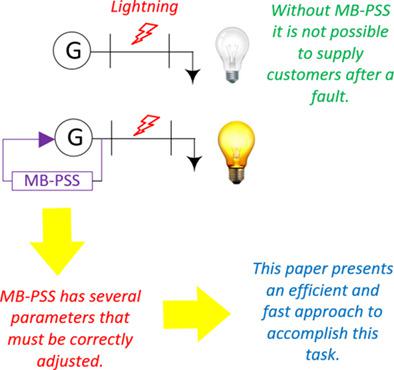当前位置:
X-MOL 学术
›
Int. Trans. Electr. Energy Syst.
›
论文详情
Our official English website, www.x-mol.net, welcomes your
feedback! (Note: you will need to create a separate account there.)
A pole placement approach for multi‐band power system stabilizer tuning
International Transactions on Electrical Energy Systems ( IF 1.9 ) Pub Date : 2020-08-10 , DOI: 10.1002/2050-7038.12548 Wesley Peres 1 , Francisco C. R. Coelho 1 , Junior N. N. Costa 1
International Transactions on Electrical Energy Systems ( IF 1.9 ) Pub Date : 2020-08-10 , DOI: 10.1002/2050-7038.12548 Wesley Peres 1 , Francisco C. R. Coelho 1 , Junior N. N. Costa 1
Affiliation

|
Low‐frequency electromechanical oscillations is a topic of great concern in power system operation. Undamped oscillations reduce the power transfer capacity and can lead the system to blackouts. Since the 70s, synchronous generators operate with power system stabilizers that add damping torque to oscillations through the excitation system control. These controllers can have either a conventional fixed structure, composed by stages of gain and phase compensation, or a multi‐band structure (MB‐PSS), composed by three bands that correspond to a specific frequency range (low, intermediate and high frequency). In the MB‐PSS structure, each band consists of two branches based on differential filters (with a gain stage and lead‐lag blocks). This paper presents an approach based on the Newton‐Raphson method for tuning MB‐PSS for power systems taking into consideration several operating conditions to ensure robustness. The approach adjusts the controller's gains to place a set of poles into a region in the complex plane with a desired damping ratio. Firstly, the method is applied to the well‐known single‐machine infinite bus system represented by the Heffron‐Phillips model. Secondly, an application to the multimachine South‐Southeastern Brazilian power system is discussed considering different operating conditions. The convergence of the proposed approach is evaluated regarding the initial conditions, the desired damping ratio, and the set of monitored poles. Linear and nonlinear time‐domain simulations validate the designed controllers. Finally, it is shown that the computational effort required by the proposed approach is lower than the one required by a class of methods widely reported in the literature for MB‐PSS design.
中文翻译:

用于多频带电源系统稳定器调整的极点放置方法
低频机电振荡是电力系统运行中非常关注的一个话题。无阻尼的振荡会降低功率传输能力,并可能导致系统停电。从70年代开始,同步发电机就与电力系统稳定器一起运行,该稳定器通过励磁系统控制为振荡增加了阻尼转矩。这些控制器可以具有常规的固定结构,由增益和相位补偿的阶段组成,也可以具有由对应于特定频率范围(低,中和高频)的三个频带组成的多频带结构(MB-PSS) 。在MB‐PSS结构中,每个频带由基于差分滤波器的两个分支组成(具有增益级和超前滞后模块)。本文提出了一种基于牛顿-拉夫森(Newton-Raphson)方法的电力系统MB-PSS调优方法,其中考虑了多种操作条件以确保鲁棒性。该方法调整控制器的增益,以将一组极点以所需的阻尼比放置到复杂平面中的区域中。首先,该方法被应用于以Heffron-Phillips模型为代表的著名的单机无限总线系统。其次,考虑了不同的运行条件,讨论了在巴西东南部多机系统中的应用。关于初始条件,期望的阻尼比和监测极点的集合,评估了所提出方法的收敛性。线性和非线性时域仿真验证了设计的控制器。最后,
更新日期:2020-10-11
中文翻译:

用于多频带电源系统稳定器调整的极点放置方法
低频机电振荡是电力系统运行中非常关注的一个话题。无阻尼的振荡会降低功率传输能力,并可能导致系统停电。从70年代开始,同步发电机就与电力系统稳定器一起运行,该稳定器通过励磁系统控制为振荡增加了阻尼转矩。这些控制器可以具有常规的固定结构,由增益和相位补偿的阶段组成,也可以具有由对应于特定频率范围(低,中和高频)的三个频带组成的多频带结构(MB-PSS) 。在MB‐PSS结构中,每个频带由基于差分滤波器的两个分支组成(具有增益级和超前滞后模块)。本文提出了一种基于牛顿-拉夫森(Newton-Raphson)方法的电力系统MB-PSS调优方法,其中考虑了多种操作条件以确保鲁棒性。该方法调整控制器的增益,以将一组极点以所需的阻尼比放置到复杂平面中的区域中。首先,该方法被应用于以Heffron-Phillips模型为代表的著名的单机无限总线系统。其次,考虑了不同的运行条件,讨论了在巴西东南部多机系统中的应用。关于初始条件,期望的阻尼比和监测极点的集合,评估了所提出方法的收敛性。线性和非线性时域仿真验证了设计的控制器。最后,











































 京公网安备 11010802027423号
京公网安备 11010802027423号